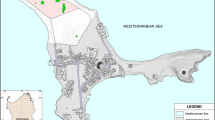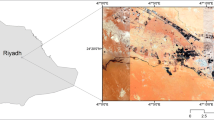Abstract
Uruk archaeological site, which located in Al-Muthanna Governorate southern Iraq, was investigated by integrated geophysical methods, ground penetration radar (GPR) and electric resistivity tomography (ERT) to image the historical buried structures. The GPR images show large radar attributes characterized by its continuous reflections having different widths. GPR attributes at shallower depth are mainly representing the upper part of Babylonian Houses that can often be found throughout the study area. In addition, radargrams characterized objects such as buried items, buried trenches and pits which were mainly concentrated near the surface. The ERT results show the presence of several anomalies at different depths generally having low resistivities. It is clear that the first upper zone can be found throughout the whole area and it may represent the top zone of the Babylonian houses. This zone is characterized by its dry clay and sandy soil containing surface broken bricks and slag mixed with core boulders. The second one underneath the top shows a prominent lower resistivity zone. It is probably caused by the moisture content that reduces the resistivity. The thickness of this zone is not equal at all parts of the site. The third deeper zone typically represents the archaeological walls. Most of the main anomalies perhaps referred to the buried clay brick walls. The map of the archaeological anomalies distribution and 3D view of the foundations at the study area using GPR and ERT techniques clearly show the characteristics of the Babylonian remains. A contour map and 3D view of Uruk show that the archaeological anomalies are concentrated mainly at the NE part of the district with higher values of wall height that range between 6 and 8 m and reach to more than 10 m. At the other directions, there are fewer walls with lower heights of 4–6 m and reach in some places the wall foot.

















Similar content being viewed by others
References
Aizebeokhai, A. P., (2010), 2D and 3D geoelectrical resistivity imaging, Theory and field design, Scientific Research and Essays Vol. 5, 14p.
Al-Hashimi, H., (1974), Stratigraphy and palaeontology of the subsurface rocks of Samawa Area, SOM, Iraq.
Baker, H. D., (2002), The Urban landscape in first millennium BC Babylonia, University of Vienna.
Barker, R.D., (1992), A simple algorithm for electrical imaging of the subsurface, First Break, Vol. 10, No. 2, 10p.
Beaulieu, P., (2003), The Pantheon of Uruk during the Neo-Babylonian period, 424p.
Buday, T., (1980), Regional geology of Iraq, Stratigraphy and Palaeogeography, GEOSURV, Baghdad, Iraq, Vol. 1, 445p.
Dahlin, T. and Zhou, B., (2004), A numerical comparison of 2D resistivity imaging with ten electrode arrays, Geophysical Prospecting, Vol. 52, 20 p.
Fassbinder, J. and Becker, H., (2001), “Uruk-City of Gilgamesh (Iraq) First tests in 2001 for magnetic prospecting”, dans Becker, H., Fassbinder, J. W.E, Magnetic prospecting in Archaeological Sites, Vol. VI, 5p.
Fassbinder, J., Becker, H. and Van Ess, M. (2003), Prospections magnetiques a Uruk (Warka): La cite du roi Gilgamesh (Irak).
Hritz, C., (2012), History and Archaeology in Southern Mesopotamia, Department of Anthropology, Pennsylvania State University Basrah.
Loke, M.H. and Dahlin, T., (2002), A comparison of Gauss-Newton and quasi-Newton methods in resistivity imaging inversion. Journal of applied geophysics, vol. 49, 19 p.
Loke, M.H., (2004), Tutorial: 2D and 3D electrical imaging surveys, 127p.
Loke, M.H., (2010), Tutorial: 2D and 3D electrical imaging surveys, 154p.
Oswin, J., (2009), A Field guide to geophysics in archaeology, Praxis Publishing, No 2009925774, Chic Ester, UK, 243p.
Pollock, S., Pope, M. and Course, Y., (1996), Household production at the Uruk Mound, Abu Salabikh, Iraq, American Journal of Archaeology, Vol. 100, No. 4, 16p.
Acknowledgments
The authors are highly grateful to Dr. Firas H. Al-Menshed and Dr. Ahmed S. Al-Zubedi for their sincere assistance in the field works. Thanks also extend to Dr. Ali Z. Al-Khashan for reading the manuscript of the present research.
Author information
Authors and Affiliations
Corresponding author
Rights and permissions
About this article
Cite this article
Al-Khersan, E.H., Al-Ani, J.M.T. & Abrahem, S.N. Integrated GPR and ERT as Enhanced Detection for Subsurface Historical Structures Inside Babylonian Houses Site, Uruk City, Southern Iraq. Pure Appl. Geophys. 173, 963–982 (2016). https://doi.org/10.1007/s00024-015-1162-2
Received:
Revised:
Accepted:
Published:
Issue Date:
DOI: https://doi.org/10.1007/s00024-015-1162-2




